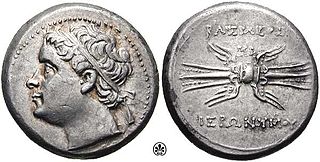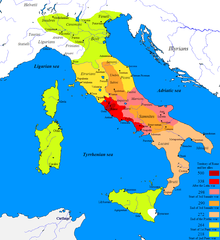
The First Punic War was the first of three wars fought between Rome and Carthage, the two main powers of the western Mediterranean in the early 3rd century BC. For 23 years, in the longest continuous conflict and greatest naval war of antiquity, the two powers struggled for supremacy. The war was fought primarily on the Mediterranean island of Sicily and its surrounding waters, and also in North Africa. After immense losses on both sides, the Carthaginians were defeated.
This article concerns the period 279 BC – 270 BC.
This article concerns the period 269 BC – 260 BC.
This article concerns the period 259 BC – 250 BC.
This article concerns the period 219 BC – 210 BC.
Year 214 BC was a year of the pre-Julian Roman calendar. At the time it was known as the Year of the Consulship of Verrucosus and Marcellus. The denomination 214 BC for this year has been used since the early medieval period, when the Anno Domini calendar era became the prevalent method in Europe for naming years.
Year 257 BC was a year of the pre-Julian Roman calendar. At the time it was known as the Year of the Consulship of Regulus and Blasio. The denomination 257 BC for this year has been used since the early medieval period, when the Anno Domini calendar era became the prevalent method in Europe for naming years.
Year 275 BC was a year of the pre-Julian Roman calendar. At the time it was known as the Year of the Consulship of Dentatus and Caudinus. The denomination 275 BC for this year has been used since the early medieval period, when the Anno Domini calendar era became the prevalent method in Europe for naming years.
Year 269 BC was a year of the pre-Julian Roman calendar. At the time it was known as the Year of the Consulship of Gallus and Pictor. The denomination 269 BC for this year has been used since the early medieval period, when the Anno Domini calendar era became the prevalent method in Europe for naming years.
Year 278 BC was a year of the pre-Julian Roman calendar. At the time it was known as the Year of the Consulship of Luscinus and Papus. The denomination 278 BC for this year has been used since the early medieval period, when the Anno Domini calendar era became the prevalent method in Europe for naming years.

Hiero II was the Greek tyrant of Syracuse, Magna Graecia, from 275 to 215 BC, and the illegitimate son of a Syracusan noble, Hierocles, who claimed descent from Gelon. He was a former general of Pyrrhus of Epirus and an important figure of the First Punic War. He figures in the story of famed thinker Archimedes shouting "Eureka".

The Battle of Agrigentum was the first pitched battle of the First Punic War and the first large-scale military confrontation between Carthage and the Roman Republic. The battle was fought after a long siege which started in 262 BC and resulted both in a Roman victory and the beginning of Roman control of Sicily.
Appius Claudius Caudex was a Roman politician. He was the younger brother of Appius Claudius Caecus, and served as consul in 264 BC.

The Mamertines were mercenaries of Italian origin who had been hired from their home in Campania by Agathocles, Tyrant of Syracuse and self-proclaimed King of Sicily. After Syracuse lost the Seventh Sicilian War, the city of Messina was ceded to Carthage in 307 BC. When Agathocles died in 289 BC he left many of his mercenaries idle and unemployed in Sicily. Most of them returned home but some, liking the climate and the prospect of adventure on a foreign island, remained. They played a major role in the lead-up to the First Punic War.

The siege of Syracuse by the Roman Republic took place in 213–212 BC. The Romans successfully stormed the Hellenistic city of Syracuse after a protracted siege, giving them control of the entire island of Sicily. During the siege, the city was protected by weapons developed by Archimedes. Archimedes, the prominent inventor and polymath, was slain at the conclusion of the siege by a Roman soldier, in contravention of the Roman proconsul Marcellus's instructions to spare his life.

Sicilia was the first province acquired by the Roman Republic, encompassing the island of Sicily. The western part of the island was brought under Roman control in 241 BC at the conclusion of the First Punic War with Carthage. A praetor was regularly assigned to the island from c.227 BC. The Kingdom of Syracuse under Hieron II remained an independent ally of Rome until its defeat in 212 BC during the Second Punic War. Thereafter the province included the whole of the island of Sicily, the island of Malta, and the smaller island groups.

Hieronymus was a tyrant of Syracuse, Magna Graecia. He succeeded his grandfather, Hiero II, in 215 BC. He was at this time only fifteen years old, and he ascended the throne at a crisis full of peril, for the Battle of Cannae had given a shock to the Roman power, the influence of which had been felt in Sicily; and though it had not shaken the fidelity of the aged Hiero, yet a large party at Syracuse was already disposed to abandon the alliance of Rome for that of Carthage. The young prince had already given indications of weakness, if not depravity of disposition, which had alarmed his grandfather, and caused him to confide the guardianship of Hieronymus to a council of fifteen persons, among whom were his two sons-in-law, Andranodorus and Zoippus. But the objects of this arrangement were quickly frustrated by the ambition of Andranodorus, who, in order to get rid of the interference of his colleagues, persuaded the young king to assume the reins of government, and himself set the example of resigning his office, which was followed by the other guardians. Hieronymus now became a mere tool in the hands of his two uncles, both of whom were favourable to the Carthaginian alliance – and Thrason, the only one of his counsellors who retained any influence over his mind, and who was a staunch friend of the Romans, was soon got rid of by a charge of conspiracy.

The Battle of Messana in 264 BC was the first military clash between the Roman Republic and Carthage. It marked the start of the First Punic War. In that period, and after the recent successes in southern Italy, Sicily became of increasing strategic importance to Rome.

Hanno was a Carthaginian general, prominent in the events leading to the start of the First Punic War.
The History of Greek Sicily began with the foundation of the first Greek colonies around the mid 8th century BC. The Greeks of Sicily were known as Siceliotes.









